Our Verdict
The Adidas UltraBoost line is a reliable cushioned pick for casual runners, whatever generation you go for. It certainly doesn’t hurt that it’s possibly the best-looking running shoe there is, either. The Continental rubber on the outsole makes it exceptionally durable and it’s almost always reduced so it offers fantastic value. The women’s UltraBoost 22 is also designed differently to suit the female foot better.
For
- Well cushioned
- Stylish
- Durable
- Often reduced in price
Against
- Heavy
- Rivals offer better performance
You can trust Coach
All hail the all-conquering UltraBoost, a line of running shoes so popular that only the Nike Vaporfly can claim to be as well known with runners and non-runners alike, although you don’t see many people walking their dog wearing the Vaporfly. That’s the key to the UltraBoost’s success – its cross-over appeal as a very durable cushioned running shoe that will happily handle a parkrun and won’t look out of place in the pub later.
- NEWSFLASH: Adidas UltraBoost Light Released (23rd February 2023)
We’ve been running in the UltraBoost since 2015, as well as offshoots such as the SolarBoost and PureBoost, and have reviewed the original and subsequent generations, including every version since the major design change in 2019 and a new model was released every year.
While the pure runner in us knows the best cushioned running shoes are lighter and more responsive if you ever want to pick up the pace. However, we’re not above wearing a running shoe that wins on style.
Adidas must know this, because the range of colourways is extensive, and there’s always a deal to be had from Adidas or a third-party retailer, and old models stick around for a long time. So we’ve collected all of our reviews here, and included the best deals our fancy Deal-O-Tron 3000 database spits out.
Adidas Women’s UltraBoost 22 Review
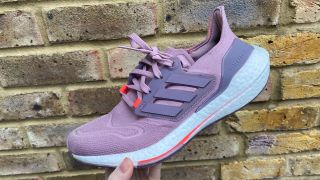
I’ve always had a bit of a problem with the Adidas UltraBoost. It’s not the weight – I’m a dedicated Hoka fan and prefer a thick wedge of foam when I’m doing the easy miles on a training plan – it’s the fit.
Two recurring design features of the UltraBoost – which you'll find among the best Adidas running shoes for every type of runner – have been the sock-like upper and the plastic lacing system, neither of which I’ve found particularly comfortable. The shoe always felt OK while running, but the upper felt uncomfortably tight across the top of my foot the second I stopped, to the point that it would hurt. Of course, you buy a running shoe to run in it, but if I’m spending £165 on a shoe, I want to be able to wear it to the gym, or to walk the dog, or to walk around the office on the days I run to work.
It wasn’t until I went for a run with another female runner that I realised I wasn’t the only one experiencing these issues. My running partner found that the sock upper would bunch up under the laces of her narrow feet, creating uncomfortable creases on the top of her foot.
Adidas has set out to improve things with the UltraBoost 22, changing the design of the women’s version. This isn’t Adidas’s first foray into female-specific footwear: in 2016 it launched the Pureboost X, a shoe designed for female feet that had a somewhat bizarre-looking floating arch above the midsole. However, tailoring the fit of Adidas’s most popular cushioned running shoe to women is a much bigger deal.
Adidas used an all-female design team and analysed scans from the feet of 1.2 million women to create the UltraBoost 22, which has a narrower heel, a lower instep and an S-curve heel to allow the achilles tendon to move more freely. Adidas has also added more support to prevent overpronation – studies have suggested women pronate more than men because we have wider hips – with an extra plastic support rail on the outsole.
The shoe has the same extended heel as the UltraBoost 21, designed to make the shoe more comfortable for heelstrikers, and the same Linear Energy Push system on the outsole to produce a snappier toe-off. Adidas says the tweaks to the upper and the fit of the UltraBoost 22 make the shoe 4% more efficient underfoot than the UltraBoost 21 for female runners.
The result? I’ve run approximately 50 miles in the shoe, over a number of different sessions, and am impressed with the fit. The shoe definitely feels more comfortable underfoot. Adidas has used Primeknit+ yarn, which contains 50% recycled plastic, to create an upper that has more structure and support. It’s still sock-like, but I no longer feel like I’m losing the circulation in my toes after walking home from parkrun, with the bootie upper feeling like it has a lot more give. I’m a UK 5 and found the shoe to fit true to size.
The lacing system has also been tweaked. There’s still the same plastic lace system as in its predecessor, but the lower laces are connected with two material loops rather than going through the plastic. This small change seemed to prevent the pressure and hot spots I’ve experienced on the top of my foot. The tongue is also now more cushioned, which feels reassuringly comfortable.

The instep is narrower in the UltraBoost 22 and sits slightly higher on the ankle. Adidas says this is based on scans of female feet and is designed to prevent heel slip and blisters, as well as helping the shoe fit more securely. Considering you’re running on such a thick wedge of foam the shoe felt remarkably stable, even on faster sessions on wet, slippery pavements. I also didn’t have any issue with blisters and ran pretty comfortably in these straight out of the box.
During the launch event of the UltraBoost 22 in London, Adidas designers explained how the Boost midsole foam has also undergone some changes for the female-specific UltraBoost. The holes in the foam of the shoe are larger and more flexible, designed to give a softer landing underfoot.
That said, compared with the midsole of, say, the Nike ZoomX Invincible Run, I wouldn’t call the UltraBoost foam soft. It’s definitely stiffer and less comfortable than previous UltraBoosts and has a similar running experience to the UltraBoost 21. This isn’t necessarily a bad thing – if you’re a beginner looking for a shoe that can cope with faster paces, the firmer foam is better than anything too squishy, but personally, I miss the plusher feel of the older Boost models.
Weighing 286g, the shoe is slightly lighter than the UltraBoost 21, which weighs 297g, but it still feels pretty hefty underfoot during a progression run or speedier miles. The men’s UltraBoost 22 weighs 333g, compared with the UltraBoost 21 which weighs 340g.
If I review this shoe as a shoe for easy runs, which is what I’d argue it’s designed to be, it’s comfortable, rolls nicely underfoot and has seen me through runs up to 10 miles (16km) without any complaints. That said, I’m not sure it’s going to replace the Nike Invincible or Hoka Bondi 7 for my easy training miles. For me, the LEP system makes the shoe that little bit too firm underfoot to be enjoyable over long distances, but if you’re a beginner looking for a shoe to run shorter distances and wear in the gym, this shouldn’t put you off.
Faster runners shouldn’t get swept up by the 4% energy return figure, since the weight of the shoe stops it from being all that responsive. You can pick up the pace, but you’ll feel it in your legs.
One of the main draws of the UltraBoost is the use you get when you’re not running, so if you’re looking for a running shoe that’ll look cool with jeans in the office and cope with your run-commute home, this ticks the right boxes. As a running shoe, however, while the fit for women has definitely been improved, there are cheaper and more cushioned easy running shoes on the market. – Review by Jane McGuire
Adidas UltraBoost 21 Review

The Adidas UltraBoost has long been a better running shoe than its reputation suggests. That’s largely because its stylish design pigeonholed it in some quarters as a lifestyle shoe, but those good looks didn’t stop it being a durable, comfortable running shoe in which you could happily rack up a lot of miles.
I enjoyed running in the original UltraBoost design, and while the looks of the UltraBoost 19 and 20 weren’t to my tastes, the shoes were still solid, especially for easy efforts.
Unfortunately the new UltraBoost 21 is neither quick nor especially comfortable for easy running.
The main change is the addition of even more Boost foam. There’s 6% more in the midsole, which is a fairly significant increase given just how much Boost was already packed into the UltraBoost 20.
It’s not hard to see where it’s been added either. The sizeable rear end of the shoe stands out as soon as you look at it. This is intended to make it more comfortable, especially for heelstrikers, but as a heelstriker myself I didn’t feel like I got a lot from this big chunk of foam.
The shoe is now heavier than ever too, at 361g in my UK men’s 9 – a considerable increase on the already heavy UltraBoost 20, which was 346g. Shoes can feel lighter when running than the simple weight figure indicates, but the UltraBoost 21 doesn’t achieve that feat.
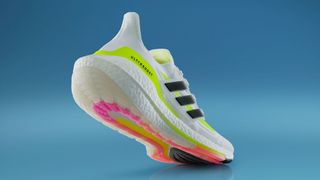
In an attempt to get some pace into the shoe Adidas has inserted its Linear Energy Push torsion system, which more or less amounts to a forked shank you can see on the bottom of the shoe. It runs from the midfoot into the forefoot and is designed to add some extra snap to your toe-off.
This works to an extent. At an easy pace you get a smooth roll through your footstrike and some added pop to your toe-off, but it doesn’t make it quick enough to work as a versatile shoe that can handle tempo or interval runs as well as easy efforts. It also makes the ride stiffer and less comfortable compared with past UltraBoosts.
The result is an awkward shoe that ends up not being great for any kind of running. The usual UltraBoost plus points still apply, in that I’m sure it will be very durable and it’s more stylish than most running shoes, but it’s not the enjoyable cruiser that past versions have been.
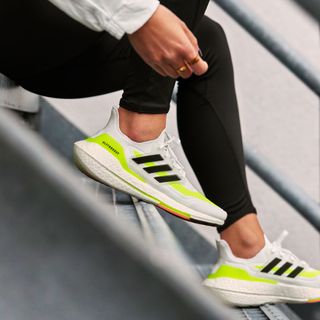
The UltraBoost 21 was true to size for me, with the snug fit typical of the sock-like uppers used in the range. The shoe uses 75% recycled material to make 50% of the upper, which is a roundabout way of saying the upper is three-eighths recycled. Which is good, although I’d hope to see those numbers increase in future releases.
The UltraBoost is also expensive, which is partly because it’s also a lifestyle shoe, but it just adds another reason to look elsewhere. There are many great easy-run shoes available for less than £160, with the likes of the Nike Pegasus 37 and Asics Novablast nearer £100, and the very comfortable Brooks Glycerin and durable Nike Infinity Run 2 at £140.
If you find the ride was more comfortable and like its look, £160 is OK value considering the use you’d get outside of running. However, the awkward ride of the latest version means it’s not a top contender in the cushioned training shoe bracket, no matter how much you like its style. – Review by Nick Harris-Fry
Adidas UltraBoost 20 Review
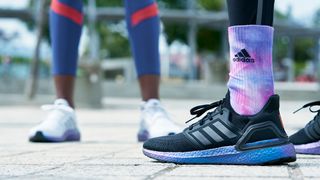
After making significant changes to the UltraBoost formula for 2019, Adidas has opted for a far more minimal update for the 2020 edition of the shoe. That may be why the marketing campaign for the UltraBoost 2020 has been all about space, rather than the shoe itself.
The space theme comes as a result of Adidas’s partnership with the International Space Station (ISS) US National Laboratory. In practical terms all that partnership really means for the shoe is that it has a slightly space-y look, mainly because of the iridescent Boost foam on some colourways. Which I do like, to be fair.
However, the changes to the structure of the shoe itself are largely confined to the upper, which now features Tailored Fibre Placement technology. This means targeted support to hold your foot in place on the run, because knitted uppers can be a little loose especially when rounding corners, though I didn’t really have this problem with the UltraBoost 19.
The changes to the upper are noticeable though. It’s certainly tighter, to the point where you can’t slip the shoe on without undoing the laces like you could with every past UltraBoost, which is a little annoying in truth. However, when running on wet and icy pavements in winter it’s no bad thing to have a more secure fit up top.

Otherwise the UltraBoost 20 offers the same features as the 19. The large slab of Boost foam in the midsole makes for an enjoyable bouncy ride, and that foam is incredibly durable. When you add in the Continental rubber outsole, which grips well and also lasts, for all practical purposes, forever, you have a shoe you’ll be able to use for many hundreds of kilometres.
The shoe is particularly good for long and easy runs, but although it’s quite hefty you can also use it for faster runs thanks to the responsive Boost foam. It would be a great option for beginner runners taking on a marathon.
It does come at a cost, but the £160 price is offset somewhat by the fact you can wear the UltraBoost 20 when not running too, since it’s significantly more stylish than the average running shoe.
Adidas UltraBoost 19 Review

Meet the new Boost, which for the first time is not the same as the old Boost. Since Adidas launched the original UltraBoost in 2015 it has largely been content to tinker with the formula of combining impressive Boost cushioning with a fashionable knitted upper rather than overhaul it with each new edition. That is until the arrival of the new UltraBoost 19, which sees Adidas making some substantial changes to the shoe.
That starts with whacking 20% more Boost foam into the midsole, which Adidas has done without adding anything to the weight of the shoe (310g for men’s size 8.5 UK). The upper has also been updated, with a Primeknit 360 sock that completely wraps the foot sitting on top of the Boost foam.
The midfoot cage has been changed too, which will delight many runners, especially those who took to cutting off the plastic on the original UltraBoost because they found it uncomfortable. On the UltraBoost 19 the cage has been replaced by a translucent mesh that locks the foot in place without imposing itself.
What really matters, of course, is what these changes mean to your experience when running in the shoe. And the good news is that the ride has improved, especially in terms of how secure the fit of the upper is.
Past UltraBoost shoes haven’t really locked the foot in place: the knitted upper was comfortable but a little sloppy when running fast or taking sharp turns. The UltraBoost 19’s upper is a full sock that sits on top of the midsole, and the knit is less stretchy than in past editions, especially around the forefoot, resulting in a more secure fit.
That fit hasn’t come at the cost of comfort, either – quite the contrary. The mesh around the midfoot is undoubtedly more pleasant to wear than the old plastic cage, while the heel counter, which is now a wire frame rather than a piece of plastic, allows the heel to expand on landing without encountering uncomfortable resistance.

The difference in the ride of the shoe is less pronounced, but it is certainly firmer than the original UltraBoost. The huge chunk of Boost on the bottom does make the UltraBoost 19 a little unwieldy if you try to run fast, but it’s great for easy and steady runs, especially over longer distances when the energy-returning properties of the Boost foam help you bounce along merrily without slacking your pace.
Part of the appeal of the UltraBoost shoe has always been that it’s stylish enough to wear out and about when not running, which I’m not entirely convinced remains the case with the new “unfinished” style. Then again, no-one’s going to mistake me for a shoe trendspotter, so maybe Adidas has nailed it.
The German company will certainly hope so, because other brands have emulated the success of its original by releasing shoes that offer a similar combination of boundless bounce and street-ready looks. The Nike Epic React Flyknit is our favourite of these, and it’s significantly lighter than the UltraBoost (239g men’s size 9), making it a more versatile option for different kinds of running.
Adidas’s SolarBoost matches the Epic React more closely, since it has enough Boost cushioning for long and easy runs while being a little lighter and more responsive than the UltraBoost. Neither the SolarBoost or Epic React, however, quite matches the comfort of the UltraBoost over long distances, but they are far better suited to faster running and are decent race-day options too.
The redesigned UltraBoost is a better shoe than its predecessor, with a more secure upper and a firmer, bouncier ride, even if I’m not a fan of the new style. It’s great fun for long distances at an easy pace, but it wouldn’t be my first, second or third choice for any other types of running – and there are now several other shoes that can rival its comfort while being lighter and more responsive.
Adidas UltraBoost Review
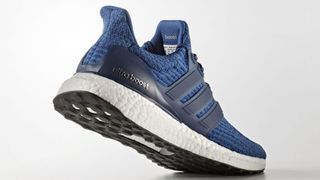
When Adidas launched the UltraBoost in 2015 there weren’t many, if any, running shoes like it. This was the only place you could find such a combination of style and substance in the form of Adidas’s impressive Boost cushioning and the fashionable knitted upper.
However, the landscape has changed since, and more brands have brought out proprietary foams that mimic the bounce of Boost and combined them with stylish uppers. Some shoes, like the Nike Epic React or Pegasus Turbo, are also far lighter than the UltraBoost, making them better suited for faster training runs and racing. The UltraBoost also faces increased competition from within, with Adidas having launched the lighter, speedier SolarBoost in early 2018.
Despite all this extra competition, the UltraBoost remains an incredibly popular shoe with all kinds of runners and Adidas has done little to change the formula of the original shoe in the updates since it launched. You still get the comfortable and stylish Primeknit upper, which is a little tighter on the latest version of the shoe to provide a more secure fit, and you still get a chunky slab of Boost cushioning on the bottom.
That Boost cushioning still delivers a responsive and comfortable ride, returning energy in spades to help you bounce merrily through whatever distance you’re taking on. I found the UltraBoost particularly good for helping to maintain a decent pace over long runs and cruising through easy runs.
However, when you want to push the pace the UltraBoost is slightly cumbersome, especially when compared with lighter shoes in Adidas’s line-up like the SolarBoost or Boston. It’s not built for sprinting or racing, and although the upper’s now tighter than in past versions of the shoe, I still found that my foot would slip a bit when turning corners at speed. There’s a plastic cage that wraps around the midfoot section of the UltraBoost, which helps a little in this regard, but if you tighten the laces too much the cage can become uncomfortable.
On the plus side, the Continental rubber on the outsole provides excellent grip in all conditions, although the knitted upper is less suited to wet weather and will do nothing to stop your foot getting drenched if the heavens open.
While it would never be my first choice for speed sessions, the UltraBoost is still a versatile running shoe that you can tackle all of your running in, and it is a joy to pull on for easy days in particular. If you’re a runner who has two or three shoes in the wardrobe at any one time the UltraBoost pairs perfectly with the Adios (for racing and fast training) and the Boston (for the rest of your running). And even if you only ever have one pair of shoes in your arsenal the UltraBoost bears consideration, because not only is it a solid all-rounder, it’s one that you can wear with your civvies without people casting pitiful glances at your hideous footwear. – Review by Nick Harris-Fry

Jane McGuire is a fitness enthusiast, with years of experience writing about running shoes, sports bras, and just about everything in between. When she's not training for a marathon, you'll find her walking the dog (and documenting it on Instagram).

